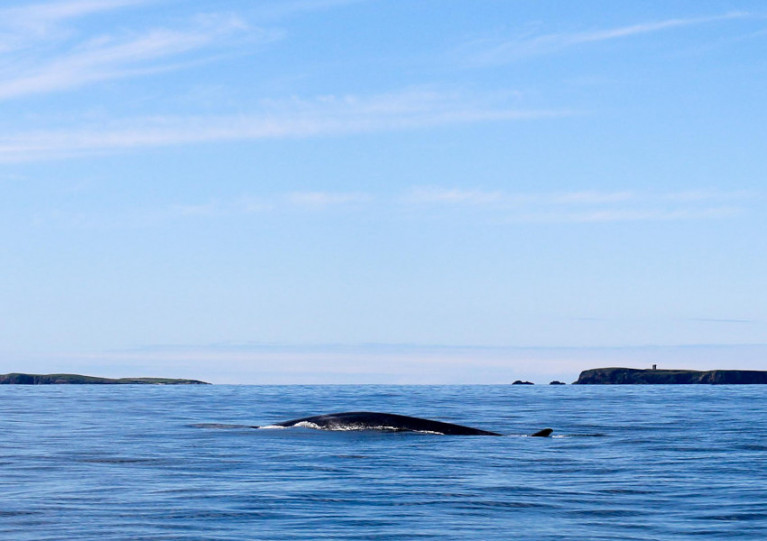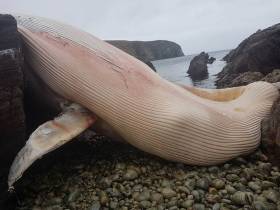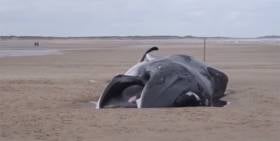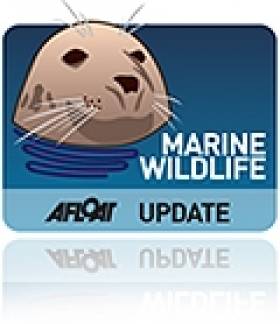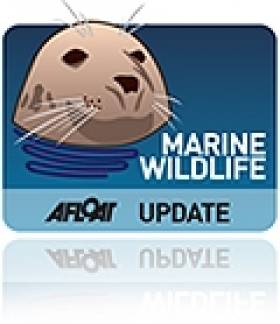Displaying items by tag: fin whales
A fin whale found stranded near Ballinskelligs, Co Kerry at the weekend will not be subject to a post-mortem examination to determine its cause of death, the Irish Whale and Dolphin Group (IWDG) has said.
The whale was visited by IWDG strandings officer Stephanie Levesque under the Deep Diving and Rare species Investigation Programme (DDRIP).
DDRIP was initiated by the IWDG in 2022 in response to a well-documented increase in recent years in cetacean stranding records reported through the IWDG’s stranding scheme.
“Unfortunately this individual was too decomposed for a full post-mortem,” the IWDG said. “Stephanie collected a number of samples useful for biological studies but [was] not able to establish cause of death.
The whale was a male measuring 19 metres in length which would have made it not fully grown. Samples of skin, blubber and baleen were taken, the group added.
As for next steps, the IWDG says that Kerry County Council is intending to let the remains rest in situ as it is on private land in a secluded area.
Irish Whale and Dolphin Group Establishes Fin Whale Photo Identification Catalogue
The Irish Whale and Dolphin Group (IWDG) has combed through years of accumulated images to make a start on its new photo identification catalogue for fin whales in Irish waters.
And the group is calling on anyone with good-resolution images of the often elusive cetaceans to submit them to the catalogue for appraisal and potential matching.
“It only takes one strong image to reveal an animal’s identity,” IWDG sighting officer Pádraig Whooley says, “and in time this citizen science resource should begin to tell us more about the life histories of the wider cohort that arrive annually along the Irish South Coast most years during May.”
Whooley explains that recording of fin whales in Ireland — historically the more dominant of Ireland’s two large baleen whale species — had taken a backseat to that of the larger, more easily photographed humpback whales which began arriving in greater numbers a decade ago.
Another reason for this shift in emphasis, Whooley says, was the “international significance” of Ireland’s rising numbers of a marine wildlife species, in humpbacks, that has been more susceptible to commercial exploitation.
In recent weeks, however, Whooley says the time was right to revisit the IWDG’s trove of fin whale images which he and Andrew Malcolm have “whittled them down” to a starting set of “53 well-marked individuals, several of whom have been recorded over multiple years”.
“As with the humpback catalogue, these animals have been allocated unique references with associated sightings histories and are stored on a Google drive for ease of matching new images and sharing with colleagues both at home and overseas,” Whooley adds.
It’s hoped to grow this collection with contributions to the public to [email protected]. The IWDG asks that submissions be of at least medium to high resolution, sharp and shot within 100 metres of the focal animal. Especially desired are photos that show “a well-marked dorsal fin or linear scars, blemishes, signs of ship-strike injuries, entanglement marks etc” that will ease identification.
“Given the nature of fin whales and what appears to be declining numbers in Irish waters, this catalogue will no doubt throw up many challenges in the years ahead, but we’re confident there will also be some fascinating discoveries that will help inform future management plans for the largest whale in our coastal waters,” Whooley says.
“As with the humpbacks, one of the first questions we’ll be hoping to answer is, where are their breeding grounds? It’s remarkable that thus far this vital piece of ecological information has eluded whale researchers… perhaps the Irish fin whale catalogue will help solve this mystery?”
An abridged version of the fin whale catalogue will be made available on the IWDG website for citizen scientists to try to match any fin whales they’re fortunate to encounter.
Wildlife Charity Calls for Increased Protection Over Waters West of Ireland and Other Key ‘Whale Superhighways’
The waters west of Ireland host one of the world’s “whale superhighways” which are under various threats from human activity according to leading conservation charity.
And the WWF is now calling on the world’s governments to extend legal protections for marine wildlife such that they overlap these “blue corridors”.
The 2022 report from the charity’s Protecting Blue Corridors project presents a visualisation of the satellite tracks of 845 migratory whales around the globe and “outlines how whales are encountering multiple and growing threats in their critical ocean habitats”.
It identifies the waters off Ireland’s West Coast as hosting a major migratory path for fin whales that traces all the way from Morocco in North Africa to the Arctic Circle.
But it also notes that these long-distance migrations are under considerable threat from human activity, whether that be climate change, ghost nets, noise and plastic pollution, offshore mineral exploration, shipping or whaling.
“Whales are a flagship species of our oceans and play a crucial role in the overall health of the marine environment,” said Chris Johnson, global lead of WWF’s Protecting Whales & Dolphins Initiative.
“We have to look at our ocean as ‘one ocean’ without boundaries. Only through building new and innovative collaborations worldwide and protecting their entire range, can we safeguard whales for future generations.”
Iceland Set to Halt Commercial Whaling From 2024
Falling demand for whale meat has prompted Iceland to announce and end to commercial whaling from 2024, as RTÉ News reports.
The move will leave Norway and Japan as the only countries that hunt whales for commercial purposes.
In an article published in the Morgunbladid newspaper, Icelandic fisheries minister Svandis Svavarsdottir said: “There is little proof that there is any economic advantage to this activity.”
Despite having sizeable annual quotas for minke and fin whales, neither of Iceland’s two main licence holders have hunted whales for a full season since 2018 — and only one has been killed in the past three years.
Meanwhile, among other issues affecting exports, Japan’s resumption of whaling has all but eliminated demand for such meat from the Icelandic fishery.
Iceland’s relationship with the whales in its waters was documented in a 2020 film that followed an Irish Whale and Dolphin Group expedition in search of humpback whales, as previously reported on Afloat.ie.
IWDG Confirms First Validated Fin Whale Sighting For Co Donegal
The Irish Whale and Dolphin Group has conformed the first validated sighting of a fin whale off Co Donegal.
Liz Morrow captured images of the solo large whale in Donegal Bay off Slieve League earlier this month, estimating it to be around 18 metres in length.
Fin whales are a common occurrence in Ireland’s South West and the Celtic Sea, but have never before been spotted in the inshore waters of the colder North West.
However, with the later sighting of a humpback whale breaching off Malin Beg, it could be a sign that larger marine wildlife are exploring new territory north of Sligo.
“Any large whales that simply look too large to be a minke or humpback and produce a powerful columnar ‘blow’ on surfacing, should be considered as likely candidates,” the IWDG suggests.
“They will often be accompanied by common dolphins who hunt the same sprat and herring shoals and they never lift their tails before diving.”
Suspected fin whales are best approached from the right side and photographed at the head and rostrum “which should reveal the diagnostic lower white right jaw”.
Fin Whale Carcass Surprises Donegal Island Residents
#MarineWildlife - Residents on Arranmore off the Donegal coast were surprised to find a rare whale carcass washed up on their island over the weekend.
According to BBC News, the 20-metre cetacean is believed to be a fin whale, an endangered species not normally spotted so close to Irish shores.
Though photo opportunities may be tempting, the public has been urged to stay away from the carcass for health and safety reasons.
Fin whales are sometimes spotted offshore, says Dave Wall of the Irish Whale and Dolphin Group (IWDG), who added that this whale was likely dead for some time before its carcass beached.
It’s not known what causes the fin whale’s death. But marine debris — especially microbeads from bathroom products – is a growing threat to all whales, dolphins and porpoise in Irish waters, as the IWDG recently reported.
Citing a new study that found marine debris (such as plastic bags and fish hooks) in the digestive tracts of 8.5% of cetaceans examined, the IWDG highlights that micro-plastics were present in the guts of every animal in the study.
“While larger marine debris has been shown to cause impaction of the gut and other complications which can lead to death, the impact of micro-plastic contamination is not known,” says the group.
“It is thought it can act as a vehicle for persistent pollutants, which adhere to the large surface area resulting in a potential increase in contaminant burdens in marine mammals.”
The IWDG has more on the study HERE.
Mystery Of Fin Whale Beaching On UK’s North Sea Coast
#MarineWildlife - Marine scientists have been puzzled by the recent beaching of a whale rarely seen off the east coast of England.
According to the Guardian, the carcass of a 12m fin whale washed up at Holkham in Norfolk last Thursday afternoon (20 October), far from its usual waters between Britain and Ireland.
“You never get them in the North Sea, so what it was doing there, we have no idea at the moment,” biologist Dr Ben Garrod told the newspaper.
It’s not yet known what causes the marine giant’s death, though collision with a vessel in the North Sea has been mooted as one possibility, as the Eastern Daily Press reports.
Whale Sightings Boost In Sunny South East
#MarineWildlife - Whale sightings are on the increase in the South East this week as the season tapers off, according to the Irish Whale and Dolphin Group (IWDG).
"As large whales don't keep to our calendar year, this annual south east flurry of large whale sightings represents the tail-end our our large whale season," says the IWDG's sightings officer Pádraig Whooley.
"And what a season it has been, especially for the humpback whale, which have enjoyed a record year both in terms of frequency of sightings since they first appeared in early May off the Slea Head Peninsula."
The latest spots were made both on land – by Andrew Malcolm and Ann Trimble from Ardmore Co in Waterford at the weekend – and on a whale-watching trip with Martin Colfer's South Coast Charter Angling, recording a humpback whale and more than five fin whales between them.
And there might still be time to head down to the Sunny South East to catch a glimpse of these ocean giants before they depart for the spring.
#MarineWildlife - The Irish Whale and Dolphin Group (IWDG) has proposed a restriction of seismic survey activity on the slopes of the Irish continental shelf and the Porcupine Seablight.
The IWDG says its move "stems from an increasing body of evidence which indicates that the Irish Shelf Slopes and Porcupine Seablight are an important migration route and opportunistic foraging area for blue whales and fin whales from August to March each year.
"Humpback whales are also known to migrate along a similar route in the winter and early spring," it added in a statement.
The cetacean conservation charity as expressed concern at what it perceives as "a large increase in seismic survey activity in the Porpcupine Seablight during the main migration period and recent evidence of disturbance to these migrating whales by seismic surveys."
As a result, the IWDG has proposed to the Petroleum Affairs Division of the Department of Natural Resources that seismic surveys – such as that scheduled to be conducted in the Porcupine Basin this September – be "restricted to the months March to August, outside of the migration period, in order to minimise disturbance to these highly endangered whale species."
According to the group "similar measures" have been successful in other parts of the world, such as off South Africa, where whales "seasonally occur in large numbers".
The IWDG's proposal is available as a PDF to download HERE.
#MarineWildlife - Late summer brings fin whales flocking to West Cork in big numbers, with the Irish Whale and Dolphin Group estimating at least 20 of the second-largest ocean species sighted between Seven Heads and Galley Head.
Indeed, as IWDG sightings officer Padraig Whooley writes, the gathering "is certainly the largest validated aggregation of this species so far this year" and comes some months ahead of the usual peak from October to December.
Recommended spots for watching these fin whale visitors - though you will need some decent binoculars to get the best views - are the aforementioned Galley Head and Seven Heads as eel as Cloghna Head, Dunworley and Sandscove.
Kerry has its own share of whale visitors, with a "lovely run" of humpbacks in recent weeks, while East Coast residents aren't left out, either, with a rare sighting of a minke whale in the Irish Sea some 20km off Bray Head over a week ago.
In other cetacean news, West Cork has become home to a new solitary dolphin in the form of Clet, a bottlenose who's been spotted in Glandore, Baltimore and Schull after time from Devon, Cornwall, South Wales and originally France.
Yet as IWDG welfare officer Paul Kiernan warns, Clet might appear cute but he's very much a wild animal, with reports claiming a swimmer off Sherkin Island was "aggressively pushed underwater by the dolphin".
Such stories, Kiernan writes, point "to the need for people to exercise common sense and extreme caution in how best to enjoy an interaction with this very large, apex predator."
He adds: "Bottlenose dolphins are not cute and cuddly, they are not our 'friends' and nor do they benefit in any meaningful or long term way from interacting with humans."


























